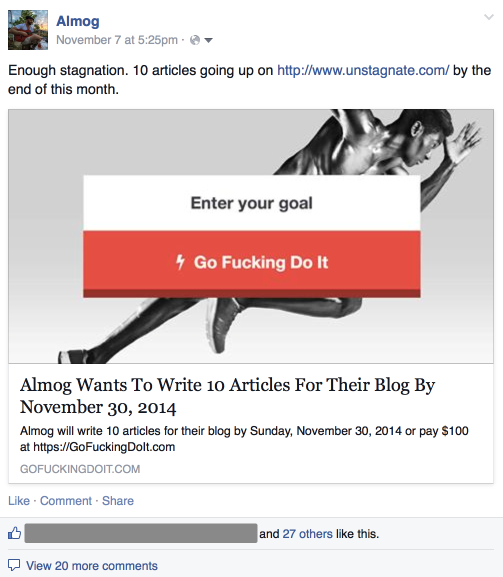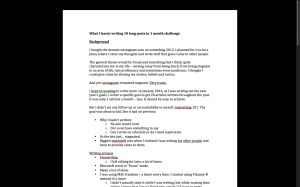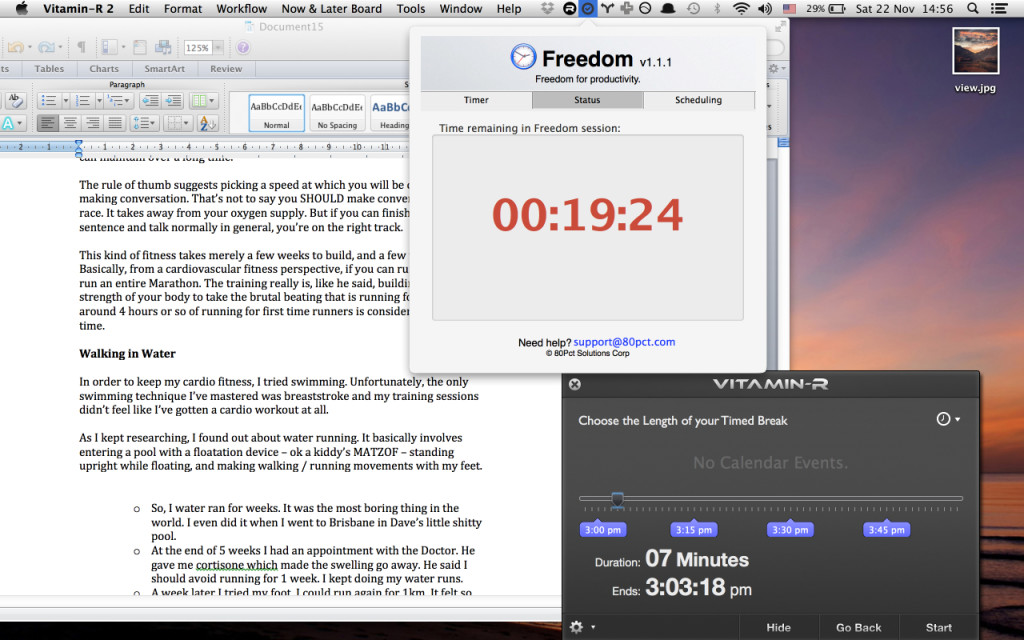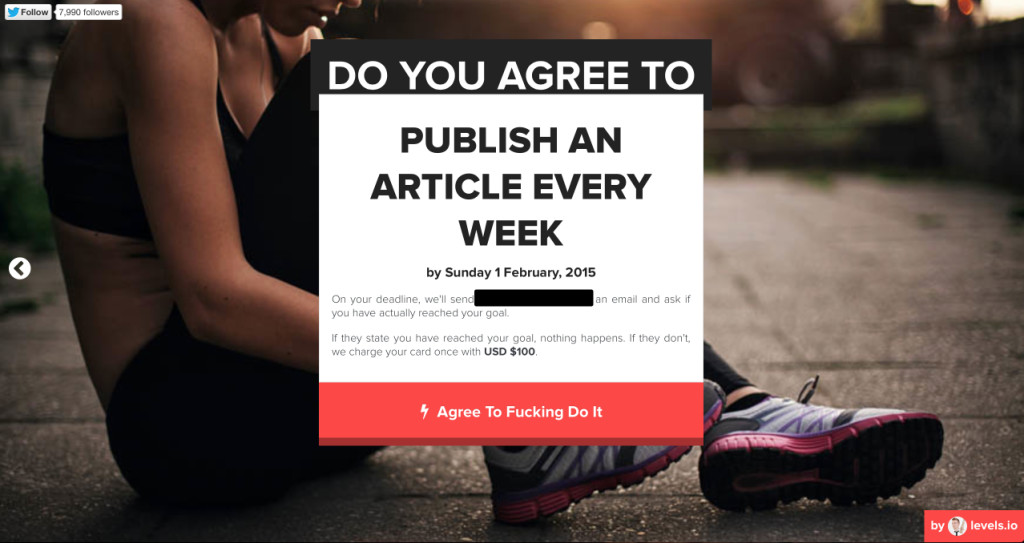Lessons From The “10 Posts in 1 Month” Challenge
I bought the domain unstagnate.com in July 2012. I planned for it to be a place where I give value by sharing my stories, beliefs and tactics. With the theme of the blog being quite general, I could write a lot of my experiences under the same umbrella.
And yet, ironically, Unstagnate remained stagnant.
There was a part of me that wanted to write more. In January 2014, as I was writing out the new year’s goals, I wrote a specific goal to write 20 articles throughout the year. It was less than 2 articles a month. It should have been easy to achieve.
But I didn’t set any follow up or accountability to myself. The goal was bound to fail, like my vague intentions to write failed in prior years.
As time went on without writing, I had growing doubts.
Do I even have something worth writing about?
Will anyone even read my stuff?
How can I summon the creative inspiration?
Contents
Committing
The common writing advice to the above doubts is “just write”. It seemed to simplistic, but it was advice I heard over and over.
It also coincided with my belief in taking action first and foremost.
On the 7th of November I decided that I wanted to finish at least 10 articles in 2014 – that would be half of my original yearly goal.
Knowing I had a lot of inner resistance and doubts about it, I created a commitment contract using gofuckingdoit.com. If I didn’t finish getting the articles written, I’d pay $100. I nominated my friend Tommy as a referee – he had been one for me in previous contracts and I knew he would take my money if I didn’t do what I said. And then I posted about it in Facebook. I now had skin in the game. I knew I was going to actually do this.
A day after making the commitment, on a Skype chat with my sister, I told her about my goal – 10 articles by the end of November. It was already the 8th and I hadn’t uploaded one yet.
“That’s an article every 2 days isn’t it?” she asked.
Yikes. I never thought about that way.
What the hell did I get myself into?
The first article
Writing for a blog – for readers – would be different than just writing for myself.
I wanted to provide value to whoever read my stuff – that was the point of publishing.
I figured value could be either:
- Mental value – Writing something that presents readers with new ideas and ways of doing things.
- Emotional value – write emotionally compelling pieces that move people.
The best would be if I could give both mental and emotional value – for example by presenting new ideas and concepts through an emotionally compelling story.
To make the best impact, I intended to keep my writing as honest and authentic as possible. I wouldn’t make statements that I wasn’t going to stand behind, nor would I describe myself as better than I am. I would just be real.
Now, I just had to figure out what to write about.
I had an old list of article ideas for Unstagnate that I’ve been adding bits and pieces to for years. I also had a few half-written articles I started for it, but I didn’t like their writing style.
Another thing I considered was to take old articles I wrote (during my dating coach life) and re-edit them so they better represent what I think and believe these days.
None of those ideas seemed very appealing. I had no idea how I would write 10 articles really.
I have been staying in the beautiful island of Koh Phangan, Thailand throughout this challenge. The day after I made the commitment, a German friend was randomly around and connected through Facebook. I had met her briefly in Barcelona earlier in 2014, and we didn’t hang out that much.
When we hung out, I found myself telling her a backstory about my life.
As I got more into the story, I started feeling excited.
I poured a lot of heart and soul into telling the story… And by the end of it I figured that this should be my first article.
Easier said than done.
Firstly, I had to start the fingers moving. To give myself directed motivated energy, I would load up on coffee – two cups of strong Java in the beginning of the day.
Then, I just went into Freewriting for 10 minutes. This was more about loosening the writing muscles and warming up for the writing day. Nothing I said or wrote had any significance. It was purely an exercise in observing my thoughts and getting started.
Then, I started writing drafts for my first post. Thousands of words were spilled on the page as I tried to recount the story as best I could. 3 drafts in, and everything I wrote just felt like absolute shit.
I even tried recording my voice as I told the story – twice. No good.
Something still felt off.
Then I realized the story was way too long in written form – I’d have to cut out a lot of how I tell it in person to make it workSo I did. I cut out some scenes and a lot of overly emotional stuff. I trusted the story was powerful enough to convey the emotions itself.
I uploaded the article on my blog on the 10th of November when I felt it was “good enough” – definitely not perfect. I knew there were still grammar mistakes and structural errors but I had 9 more articles to write. No time for perfection.
After putting the first article of the challenge on my blog, I posted on Facebook to let people know that I’m going through with the challenge.
It was 530pm and I was off to see the sunset with my German friends.
Feedback
On my way to meet the Germans private FB messages started pouring through.
A friend wrote to say “solid post”, and thanked me for sharing.
Another friend told me it got her so emotional she went into the bathrooms at work because she had to cry.
Some other people mentioned how the story touched them. “Damn onions” was a funny way of putting it.
I guess there was some value in my writing after all.
I found it interesting that comments like “Very well written Almog” were said about an article I posted before I even finished editing it!
That showed me that I didn’t have to meet the standards of academic writing.
It seemed like good writing had little to do with correct grammar, sentence construction or spelling mistakes. It had more to do with an authentic voice, a good flow and a compelling subject matter.
According to current stats that first article has been shared on Facebook 24 times, had 100 likes overall, and has driven 600 different people to my site.
Someone – I don’t know who – even mailed it to their mailing list, which got another 100 viewers to the site.
It was a good start.
To keep writing… Just keep writing
Well, was it actually a good start?
Yes and no.
Because now, I had classic “second album” syndrome. The second article would never be able to be as good as the first.
The success of the first article made me put more pressure on myself to match it. It was hard to get out of this mindset of perfectionism and comparison.
How would I keep writing at that level?
What can I write about to get people to keep moving people? To keep people sharing and tweeting my stuff?
Luckily, I had more articles to write – I was really committed.
And unlike previous commitment contracts, there was a ton of public accountability.
I couldn’t just avoid posting the next article to Facebook forever. How ridiculous would I look to my friends, committing and then not following through?
That extra pressure was great. It left me with no choice or excuses.
The only way out of my bullshit artistic perfectionism – was to push through it. I had to write more.
I published the next article. It certainly didn’t get the same response as the first one. People still enjoyed it.
“Just write” was starting to sound like really smart advice.
How to Capitalize on Inspiration
When the American Novelist William Faulkner was asked whether he writes on a schedule or when he’s inspired he answered this:
“I only write when I am inspired. Fortunately I am inspired at 9 o’clock every morning.”
I started noticing that inspiration isn’t just something to wait for.
I wasn’t writing at the same hour every day, but I noticed sitting down and forcing myself to write, eventually I always got in “the zone”. It always arrived, without fail.
The question was now about how to capitalize on those moments of inspiration, flow and creativity.
Apparently, a trait that set creative people apart was how how they captured and acted out on their inspired insights. This was true for writers, business people, even army generals.
Even before the challenge, I attempted to adopt that trait, trying to use my inspiration as best I could.
For example, sometimes I would get an idea for an article, and I wrote that idea in an “article ideas” file.
But before committing to the writing challenge, it seemed something about my “Inspiration Capitalization” wasn’t good enough.
An idea never seemed inspiring after a few days. I looked at the summarized idea and couldn’t remember how I thought I could write an entire article on it.
I think a big reason I never completed full posts from an idea before the challenge, was amongst other reasons, not being able to relate to an inspired idea being articulated in a few words.
During the challenge, however, things were a bit different.
While writing posts, I would get ideas for other, completely different posts. Even though I was in the flow for the post, I felt like emptying my mind of those ideas would help me complete the current article. A mind free of distraction is essential to be in the flow.
So, this time, instead of just writing down an idea – I wrote an entire structure for the post. Each bullet point was a thought I wanted to say about the topic. I kept writing until I felt my mind was “empty”, and saved the new article structure in its own file – not the general ideas file.
And this article you’re reading now was one that came to me during one of the other articles. How meta.
Now, reading the entire list of ideas, I could much more easily connect to the inspired energy I had when I first thought of them. I could feel excited about writing this article, even 5 days later.
This is important to mention – I still kept to the same rule of thumb. I would always pick the idea that felt the most exciting, to maintain a high level of passion in my writing.
And so, another way of capturing inspiration was to notice how I felt when I talked about various topics or told a personal story . If I got charged up while telling it – I knew it was a winner.
I think focusing on feeling (good or bad) as my rule of thumb charged my posts with more emotion and made me enjoy the writing process more. I believe that came through.
Writing habits
Eventually I developed a set of writing habits that help me get words on page.
Specifically, these helped me go past writer’s block, maintain a good level of energy throughout writing and not lose focus. Your mileage my vary, but here are some suggestions.
• Coffee – I always had coffee – almost too much. Caffeine helps me go beyond excuses and just write. I find I need a good defined task otherwise coffee just gets me anxious and distracted. For example, free writing or fleshing out an article that has a rough structure in bullet points – perfect. I just kept the fingers moving and ploughed ahead. However, something vague and undefined like thinking of article topics while caffeinated – bad.
• Light food – this is kind of obvious, but I wanted to maintain a good level of energy while writing. If I was hungry, I got distracted. If I was too full and heavy, I also couldn’t concentrate. So while writing I focus on mostly vegetarian food, snack on fruit for quick energy, and avoid heavy carbohydrates like rice, pasta or bread.
• Immaculate writing space – I had a spot in my room where I did nothing but write. It was a little square table and a chair that was just comfortable enough. There was nothing on the table, and nothing in front of me in my field of vision – in other words, zero distractions. I found that facing a wall was a lot less distracting, then facing a window or a view – which always made me want to go outside.
• Freewriting – some days I just didn’t feel like I was in the writing mood. So, after my coffee, I made myself freewrite. I would start my session by reminding myself that it doesn’t matter at all what I write, I could write in gibberish or even numbers, but I had to keep my fingers moving. The focus was just on not stopping at all. This was a great warm up and good for getting “in the zone”.
• MS Word “Focus” mode – I hadn’t used this much before, but this worked perfectly. In the menu, choose View > Focus. The view changes to show just the article on a black background. This made focusing on writing and nothing else, much easier:
• No Internet – If I felt like I was stuck in an Internet browsing loop (facebook-email-news-facebook-…), I didn’t go too hard on myself and tried closing all the windows – that wouldn’t matter anyway. I just kept open whichever pages I was still reading (usually news articles) and then used this little $10 app called MAC Freedom. All it does is cut the Internet from my machine, making it nothing but a typewriter, for as long as I define. The only way out is to restart the computer. After using it to block everything, I could finish whatever articles I had open at leisure, knowing fully well that when I finish I’ll have to start writing. This is great for any type of offline work.
• Work in short bursts – The Pomodoro Method recommends working in bursts of 25 minutes, and then taking a 5-minute break. I found I wanted more flexibility than that. For example, starting with shorter 10 or 15 minute bursts made it easier to go past writers block. Sometimes I wanted to take longer breaks that most Pomodoro apps just don’t support. So, I used a Mac OSX app called Vitamin R-2, which helped focus in other ways. It has a lot of great little tools. Usually I would still have MAC Freedom running even on my breaks, so I didn’t browse Facebook and didn’t get distracted.
• Write first, edit later – I tried to write as “train of thought” as I could. That made the eventual articles flow much better. However, while writing like this, I made a lot of mistakes. I kept the editing for later. In fact, some times I would upload an article without editing, let alone reading what I had written. Then, later, when it already was online and getting view, I would edit it, bit by bit. In my opinion, good writing is a lot more about how an article flows then about using perfect grammar, spelling or sentence structure. Mistakes can be distracting to the flow of reading an article, but the focus should be on giving value to readers, not on perfection. Even an article with serious “flow” issues can be immensely powerful, just like in person, someone with imperfect English can make a powerful, moving speech.
Conclusion
I started this challenge for myself, but I also focussed on writing posts that provide value.
The feedback I’ve received from my readers has been incredibly encouraging.
People realized it wasn’t the easiest thing for me. Some goaded me to keep going. Others just let me know they liked an article or my writing. It was just what I needed.
By the end of it, I started believing that I’m a pretty decent writer. It feels good!
The journey this challenge took me on was awesome. It was great to remove the cobwebs from my writing mind and get the fingers moving.
My articles tend to be long – this meant I wrote about 1000 edited words a day from the day I took it.
I don’t intend to keep the intensity of writing this high. However, I also don’t intend to let this blog stagnate again.
So, I’m now committing to write an article every week for the next 2 months. That should be very doable. Here is my new commitment contract proof:
Keep following by joining my newly minted mailing list in the form below. Most of my readers are my Facebook friends, so there’s no way I’ll ever spam this list.
Thanks again for all your support!
Almog




